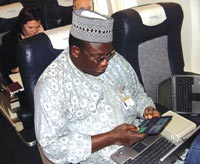|
Agenda item 1.11
WRC-03 poised to enable broadband connectivity to
aircraft passengers and crew
|

Karen N. Gielen
Executive Director,
International Regulatory Affairs
Connexion by Boeing
ITU 030067/Tony deLeo |
|
|
|
Agenda item 1.11:
"To consider possible extension of the allocation to the
mobile-satellite service (Earth-to-space) on a secondary basis in the band 14–14.5
GHz to permit operation of the aeronautical mobile-satellite service as
stipulated in Resolution 216 (Rev.WRC-2000)."
|
Member States attending the World
Radiocommunication Conference (WRC-03) have the opportunity to open the door for
the commercial deployment of a new mobile information service: the two-way
real-time broadband connectivity to aircraft passengers and crew. Already,
Lufthansa and British Airways have successfully tested one such service on a
demonstration basis over the North Atlantic. Delegates to the second Conference
Preparatory Meeting (CPM) for WRC-03 also had the opportunity to try the service
on a test aircraft at the Geneva International Airport in November 2002 (see ITU
News, March 2003).
|
 From left to right: Scott Carson, President of Connexion by Boeing, and
Wolfgang Mayrhuber, Deputy Chairman of Deutsche Lufthansa AG, during the
maiden flight of the Lufthansa demonstration of the new mobile information
service: the two-way real-time broadband connectivity to aircraft
passengers and crew
From left to right: Scott Carson, President of Connexion by Boeing, and
Wolfgang Mayrhuber, Deputy Chairman of Deutsche Lufthansa AG, during the
maiden flight of the Lufthansa demonstration of the new mobile information
service: the two-way real-time broadband connectivity to aircraft
passengers and crew
ITU 030056/Terrance Scott,
Connexion by Boeing |
This aeronautical mobile-satellite service (AMSS) will be offered to
commercial airlines to provide their passengers full Internet access —
including e-mail (with attachments), secure corporate intranet connectivity,
shopping, travel destination information, and more. In addition, broadband
connectivity will allow the airlines to improve their operational efficiencies
by providing the ability for real-time monitoring of equipment and inventories
— allowing for the faster turn-around of aircraft at the gate — as well as
dynamic weather maps, crew information services and other non-safety-of-life
services.
Agenda item 1.11 of WRC-03 addresses the possible broadening of the secondary
mobile-satellite service (MSS) allocation in the band 14–14.5 GHz, based on
the results of the technical studies performed by the ITU Radiocommunication
Sector (ITU–R) under Resolution 216 (Rev.WRC-2000). This frequency band
already includes a secondary allocation to MSS — however, aeronautical MSS is
excluded. Over the past study cycle, Working Party 8D (All mobile-satellite
services and radiodetermination satellite service) has led an extensive
programme of technical studies to analyse whether an AMSS allocation in the 14–14.5
GHz band would be compatible with the primary services allocated to the band,
including the fixed-satellite and fixed services, and secondary services,
including MSS, space research and radio astronomy services. In performing these
studies, the Working Party reviewed system characteristics of two proposed AMSS
systems.
|
* The study areas of these working parties are shown in
parenthesis.
Working Party 4A
(Efficient orbit/spectrum utilization).
Working Party 7B
(Space radio systems).
Working Party 7C
(Earth-exploration satellite systems and meteorological elements).
Working Party 7D
(Radio astronomy).
Working Party 9A
(Performance and availability, interference objectives and analysis,
effects of propagation and terminology).
Working Party 9D
(Sharing with other services, except for the fixed-satellite service).
|
Based on the contributions of Working Parties 4A, 7B, 7C, 7D, 9A and 9D*,
Working Party 8D developed a Draft New Recommendation on the technical and
operational requirements for aircraft earth stations operating in AMSS networks
in the 14–14.5 GHz band. The new Recommendation is ready for approval by the
Radiocommunication Assembly that will precede WRC-03 in June, and is
provisionally known as DNR M.[AMSS] pending that approval. It affords technical
guidelines for operation and licensing of AMSS networks to ensure compatible
operations with other services operating in the band. The Working Party
concluded that appropriately designed AMSS systems can operate on a secondary
basis in the 14–14.5 GHz band without causing harmful interference to services
having primary allocations in the band. Additional studies showed the
feasibility of AMSS systems sharing with services operating under secondary
allocations in this band. They concluded their work under Resolution 216 noting
that this allocation could be broadened to include the AMSS secondary allocation
and that no other regulatory changes are required.
 |
Delegates at the second
Conference Preparatory Meeting for WRC-03 preview a new high-speed
Internet broadband service on board a test aircraft at the Geneva
International Airport in November 2002 |
 |
CPM confirmed these conclusions and provided two methods for allocating AMSS
under Agenda item 1.11. Both methods would broaden the current secondary MSS
allocation at 14–14.5 GHz by removing the current restriction
"except
aeronautical mobile-satellite service"
from the Radio Regulations. Method B
would accompany this action with a footnote incorporating by reference the Draft
New Recommendation. These conclusions are described in Chapter 2 of the CPM
Report (Section 2.4).
Many regional bodies, including the Inter-American Telecommunication
Commission (CITEL), the European Conference of Postal and Telecommunications
Administrations (CEPT), the Asia-Pacific Telecommunity (APT) and the African
Telecommunications Union (ATU), have prepared WRC-03 proposals to make the
allocation to AMSS.
WRC-03 is thus set to take the final decisions that will propel this exciting
new service into operation for the benefit of the airline industry and the world’s
travellers, including weary ITU delegates. AMSS service is expected to be
available over all the world’s major air routes by year-end 2005.
|
About the author
Ms Gielen assumed
her current responsibilities as Executive Director, International
Regulatory Affairs for Connexion by Boeing in 1997. She leads an
international team on a broad range of policy and technical issues before
the International Telecommunication Union (ITU), the International Civil
Aviation Organization (ICAO), as well as regional and national regulatory
bodies.
She draws upon a broad range and depth of international relations,
strategic planning, business development, programme management and
business management skills. Her experience has been developed through 25
years in the commercial avionics, space and communications industries.
|
|


